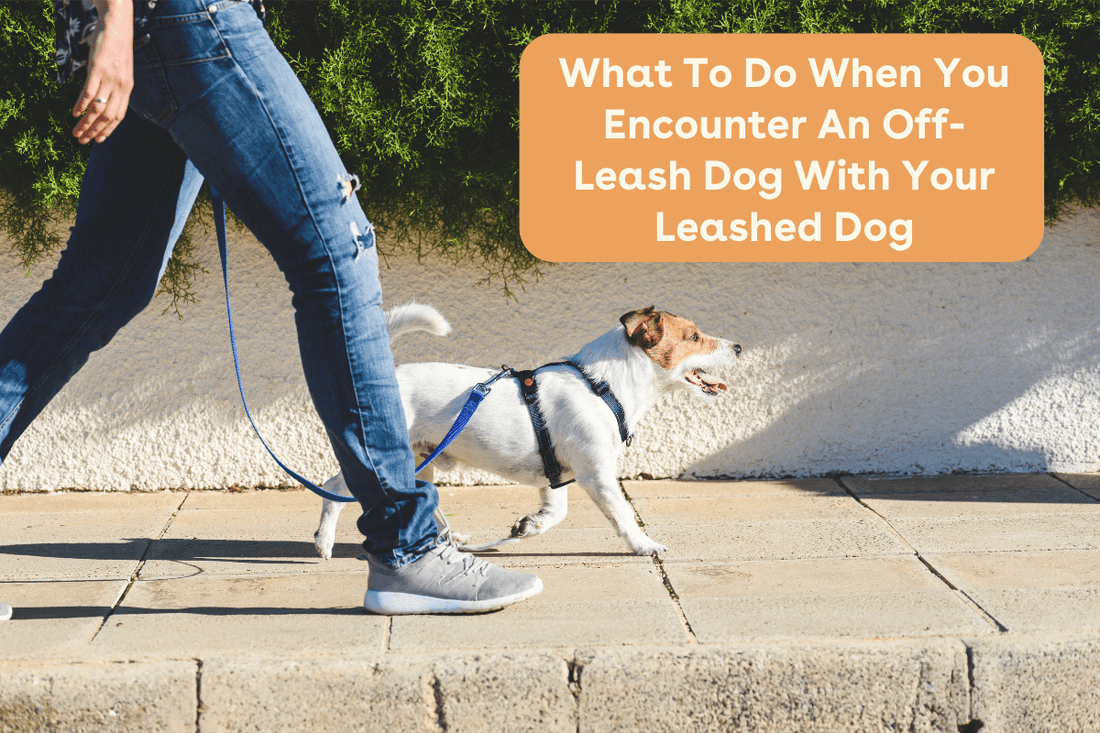What To Do When You Encounter An Off Leash Dog With Your Leashed Dog | Pupford
20 Comments Filed under pup parenting+ training
Walking your dog should be a relaxing and enjoyable experience, providing both you and your pup with exercise, fresh air, bonding time as well as mental enrichment.
However, encountering an off-leash dog can quickly turn a peaceful stroll into a stressful situation, especially if your dog is reactive or fearful.
In this blog post, we'll discuss effective techniques and strategies to handle such encounters, ensuring the safety and well-being of both dogs involved.
Table of Contents:
- Understanding Off-Leash Encounters
- Assess the Situation
- Techniques to Handle Off-Leash Dogs
- Stay Calm and Confident
- Debrief After the Encounter
Understanding Off-Leash Encounters

Many dogs become uncomfortable when they are on a leash and approached by an off-leash dog, even if they typically love other dogs and do very well with them.
This is because it takes away their option to flee, which makes many dogs feel trapped. Dogs can sense each other’s stress and if one dog feels overwhelmed or fearful, they will communicate this through their body language. This is why it is best to introduce dogs in a neutral environment where they are either both on-leash or off-leash, to make them both as comfortable as possible.
Keep in mind that not all off-leash dogs are aggressive; some may simply be curious or looking to play. However, it's essential to be prepared for any scenario to protect your dog and yourself, especially if your dog struggles with reactivity or is not dog-friendly,
Assess the Situation

The first step when encountering an off-leash dog is to assess the situation carefully. Pay attention to the body language of both dogs.
If either dog becomes stiff and tense, has a high alert tail, raises their hackles, growls, has a tight mouth, or shows their teeth, these are indicators of aggressive behaviors and to immediately get your dog out of the situation.
If either dog seems nervous or fearful, has their tail tucked, ears pinned, lip licking, panting, showing whale eyes, or doing everything they can to get away from the other dog, this is a sign that the dog is very uncomfortable and scared and should not be forced to continue with the interaction.
However, if both dogs seem relaxed and are exhibiting friendly behavior, with loose body language, neutral wagging tails, and soft faces, you may proceed with caution.
Learn more about how to read Dog Body Language!
Techniques to Handle Off-Leash Dogs

Here are some techniques you can utilize if you and your dog are ever approached by an off-leash dog to keep your distance. We recommend practicing these cues ahead of time so they become muscle memory when you actually need to use them!
Treat Bomb
The treat bomb technique involves distracting the approaching dog with a handful of treats to redirect their attention away from your dog.
Carry high-value treats that are irresistible to most dogs, such as our Freeze Dried Training Treats! Toss a handful of the treats right at the other dog's nose to redirect their attention to the ground.
While they eat the treats, you and your dog can safely get away.
Leash Twirl
The leash twirl technique utilizes the leash as a barrier between your dog and the approaching dog.
Hold the leash securely with one hand and use the other hand to twirl the leash in large, circular motions in the direction of the off-leash dog. The goal is not to hit the dog with the leash, just to create a barrier between you.
Emergency U-Turn
An emergency U-turn is a cue you can teach your dog to quickly redirect them in the opposite direction to get away from the off-leash dog.
Quickly and calmly pivot in the opposite direction, encouraging your dog to follow your lead. By changing direction abruptly, you create distance between your dog and the approaching dog, reducing the risk of a confrontation.
If you are a visual learner, check out our video with demonstrations of the three techniques listed above.
Stay Calm and Confident
Regardless of the technique you choose, it's essential to remain calm and confident throughout the encounter.
Dogs can sense our fear and anxiety, which may escalate the situation. Projecting an aura of confidence can help you maintain control and guide the interaction toward a positive outcome.
Debrief After the Encounter

Once you've safely navigated the encounter with the off-leash dog, take a moment to de-escalate and relax with your dog.
Offer praise and rewards for remaining calm and obedient during the encounter. Assess your handling of the situation and identify any areas for improvement. Reflecting on the experience can help you feel more prepared and confident in future encounters.
Encountering An Off-Leash Dog Recap
Encountering an off-leash dog while walking your leashed dog can be a nerve-wracking experience, but with the right techniques and strategies, you can navigate these situations safely and effectively.
By understanding canine body language, employing distraction techniques like treat bombs and leash twirls, or executing an emergency U-turn, you can protect your dog and yourself from potential harm.
Remember to stay calm, confident, and proactive when faced with off-leash encounters, prioritizing the safety and well-being of both dogs involved.
If you have a reactive dog, check out our Reactive Dog Course for training exercises and more tips and tricks!
